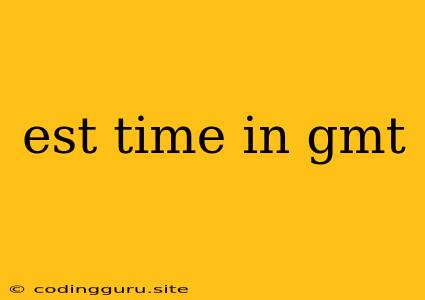Understanding EST and GMT: A Time Zone Guide
Have you ever wondered what time it is in New York while someone in London is telling you it's 5 pm? Time zones can be confusing, especially when dealing with different parts of the world. Two common time zones that often cause confusion are EST (Eastern Standard Time) and GMT (Greenwich Mean Time).
This article will delve into the world of time zones, explaining what EST and GMT are, how they relate to each other, and how to convert between them. We'll also cover some practical examples and tips to help you navigate these time zones with ease.
What is EST?
EST is the time zone used in the eastern part of the United States, including major cities like New York, Boston, and Washington D.C. It is five hours behind GMT.
EST observes Daylight Saving Time (DST), meaning it shifts forward by one hour during the summer months, becoming EDT (Eastern Daylight Time). This means that during the summer months, the time difference between EST and GMT is only four hours.
What is GMT?
GMT stands for Greenwich Mean Time, named after the Royal Observatory in Greenwich, England. It is considered the primary time zone for the United Kingdom and is often used as a reference point for other time zones around the world.
GMT does not observe Daylight Saving Time, so it remains constant throughout the year. It is also the basis for Coordinated Universal Time (UTC), which is used internationally as the primary time standard.
Converting Between EST and GMT
To convert between EST and GMT, simply remember the following:
- EST is 5 hours behind GMT during standard time.
- EST is 4 hours behind GMT during daylight saving time.
For example, if it is 12 pm in London (GMT), it is 7 am in New York (EST) during standard time, and 8 am during daylight saving time.
Tips for Managing Time Zones
Here are some tips to make managing time zones easier:
- Use an online time zone converter: There are many online tools that can help you convert between any two time zones quickly and accurately.
- Set your devices to the correct time zone: Ensure your phone, computer, and other devices are set to the appropriate time zone.
- Use a world clock app: This can be helpful for keeping track of time in multiple locations.
- Be mindful of DST: Remember to adjust your calculations for DST when necessary.
- Communicate clearly: When scheduling meetings or communicating with people in different time zones, be clear about the time zone you are using.
Real-World Examples
Here are some real-world examples of how time zones can impact our lives:
- Business meetings: If you are scheduling a meeting with someone in the UK, you need to consider the time difference between EST and GMT.
- International travel: When you travel internationally, you need to adjust your schedule to the local time zone.
- Online communication: When communicating online with people in different parts of the world, it's important to be aware of their time zones to avoid sending emails or messages at inconvenient times.
Conclusion
Understanding the difference between EST and GMT is essential for navigating a globalized world. By remembering the basic conversion rules and using the tips above, you can avoid confusion and communicate effectively with people in different time zones.
Remember, the key is to be aware of the time difference and plan accordingly. With a little effort, you can conquer the complexities of time zones and make sure you're always on time, no matter where you are in the world.
